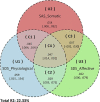Left superior temporal sulcus morphometry mediates the impact of anxiety and depressive symptoms on sleep quality in healthy adults
- PMID: 33512508
- PMCID: PMC8095089
- DOI: 10.1093/scan/nsab012
Left superior temporal sulcus morphometry mediates the impact of anxiety and depressive symptoms on sleep quality in healthy adults
Abstract
Anxiety and depressive symptoms may predispose individuals to sleep disturbance. Understanding how these emotional symptoms affect sleep quality, especially the underlying neural basis, could support the development of effective treatment. The aims of the present study were therefore to investigate potential changes in brain morphometry associated with poor sleep quality and whether this structure played a mediating role between the emotional symptoms and sleep quality. One hundred and forty-one healthy adults (69 women, mean age = 26.06 years, SD = 6.36 years) were recruited. A structural magnetic resonance imaging investigation was performed, and self-reported measures of anxiety, depressive symptoms and sleep quality were obtained for each participant. Whole-brain regression analysis revealed that worse sleep quality was associated with thinner cortex in left superior temporal sulcus (STS). Furthermore, the thickness of left STS mediated the association between the emotional symptoms and sleep quality. A subsequent commonality analysis showed that physiological component of the depressive symptoms had the greatest influence on sleep quality. In conclusion, thinner cortex in left STS may represent a neural substrate for the association between anxiety and depressive symptoms and poor sleep quality and may thus serve as a potential target for neuromodulatory treatment of sleep problems.
Keywords: anxiety; depressive symptoms; magnetic resonance imaging (MRI); sleep quality; superior temporal sulcus (STS).
© The Author(s) 2021. Published by Oxford University Press.
Figures



Similar articles
-
The left temporal transverse cortex is affected by poor sleep quality, which in turn contributes to depressive symptoms in older adults.Heliyon. 2023 Oct 7;9(10):e20751. doi: 10.1016/j.heliyon.2023.e20751. eCollection 2023 Oct. Heliyon. 2023. PMID: 37860546 Free PMC article.
-
Functional connectivity of the left inferior parietal lobule mediates the impact of anxiety and depression symptoms on sleep quality in healthy adults.Cereb Cortex. 2023 Aug 23;33(17):9908-9916. doi: 10.1093/cercor/bhad253. Cereb Cortex. 2023. PMID: 37429833
-
Neural activation underlying emotional interference of cognitive control in rotating shift workers: moderating effects of the prefrontal cortex response on the association between sleep disturbance and depressive symptoms.Sleep. 2022 Nov 9;45(11):zsac219. doi: 10.1093/sleep/zsac219. Sleep. 2022. PMID: 36107968
-
Gray matter substrates of depressive and anxiety symptoms in idiopathic REM sleep behavior disorder.Parkinsonism Relat Disord. 2019 May;62:163-170. doi: 10.1016/j.parkreldis.2018.12.020. Epub 2018 Dec 17. Parkinsonism Relat Disord. 2019. PMID: 30616869
-
The Impact of Cognitive-Behavioral Interventions on Sleep Disturbance in Depressed and Anxious Community-dwelling Older Adults: A Systematic Review.Behav Sleep Med. 2022 Jul-Aug;20(4):477-499. doi: 10.1080/15402002.2021.1933488. Epub 2021 Jun 14. Behav Sleep Med. 2022. PMID: 34120539
Cited by
-
The left temporal transverse cortex is affected by poor sleep quality, which in turn contributes to depressive symptoms in older adults.Heliyon. 2023 Oct 7;9(10):e20751. doi: 10.1016/j.heliyon.2023.e20751. eCollection 2023 Oct. Heliyon. 2023. PMID: 37860546 Free PMC article.
-
Differences in Anatomical Structures and Resting-State Brain Networks Between Elite Wrestlers and Handball Athletes.Brain Sci. 2025 Mar 7;15(3):285. doi: 10.3390/brainsci15030285. Brain Sci. 2025. PMID: 40149806 Free PMC article.
-
Aberrant Changes in Cortical Complexity in Right-Onset Versus Left-Onset Parkinson's Disease in Early-Stage.Front Aging Neurosci. 2021 Nov 8;13:749606. doi: 10.3389/fnagi.2021.749606. eCollection 2021. Front Aging Neurosci. 2021. PMID: 34819848 Free PMC article.
-
Poorer sleep health is associated with altered brain activation during cognitive control processing in healthy adults.Cereb Cortex. 2023 May 24;33(11):7100-7119. doi: 10.1093/cercor/bhad024. Cereb Cortex. 2023. PMID: 36790738 Free PMC article.
-
A review on anxiety and sleep.Bioinformation. 2025 May 31;21(5):965-968. doi: 10.6026/973206300210965. eCollection 2025. Bioinformation. 2025. PMID: 40822754 Free PMC article.
References
Publication types
MeSH terms
LinkOut - more resources
Full Text Sources
Other Literature Sources
Medical

